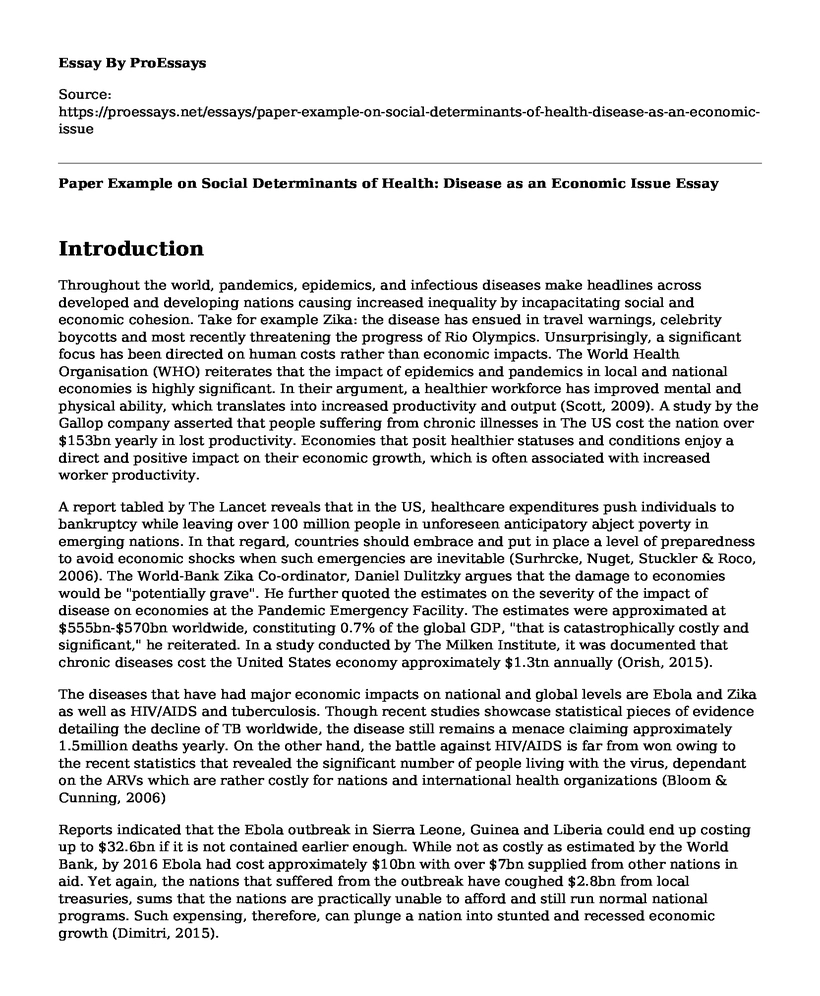Introduction
Throughout the world, pandemics, epidemics, and infectious diseases make headlines across developed and developing nations causing increased inequality by incapacitating social and economic cohesion. Take for example Zika: the disease has ensued in travel warnings, celebrity boycotts and most recently threatening the progress of Rio Olympics. Unsurprisingly, a significant focus has been directed on human costs rather than economic impacts. The World Health Organisation (WHO) reiterates that the impact of epidemics and pandemics in local and national economies is highly significant. In their argument, a healthier workforce has improved mental and physical ability, which translates into increased productivity and output (Scott, 2009). A study by the Gallop company asserted that people suffering from chronic illnesses in The US cost the nation over $153bn yearly in lost productivity. Economies that posit healthier statuses and conditions enjoy a direct and positive impact on their economic growth, which is often associated with increased worker productivity.
A report tabled by The Lancet reveals that in the US, healthcare expenditures push individuals to bankruptcy while leaving over 100 million people in unforeseen anticipatory abject poverty in emerging nations. In that regard, countries should embrace and put in place a level of preparedness to avoid economic shocks when such emergencies are inevitable (Surhrcke, Nuget, Stuckler & Roco, 2006). The World-Bank Zika Co-ordinator, Daniel Dulitzky argues that the damage to economies would be "potentially grave". He further quoted the estimates on the severity of the impact of disease on economies at the Pandemic Emergency Facility. The estimates were approximated at $555bn-$570bn worldwide, constituting 0.7% of the global GDP, "that is catastrophically costly and significant," he reiterated. In a study conducted by The Milken Institute, it was documented that chronic diseases cost the United States economy approximately $1.3tn annually (Orish, 2015).
The diseases that have had major economic impacts on national and global levels are Ebola and Zika as well as HIV/AIDS and tuberculosis. Though recent studies showcase statistical pieces of evidence detailing the decline of TB worldwide, the disease still remains a menace claiming approximately 1.5million deaths yearly. On the other hand, the battle against HIV/AIDS is far from won owing to the recent statistics that revealed the significant number of people living with the virus, dependant on the ARVs which are rather costly for nations and international health organizations (Bloom & Cunning, 2006)
Reports indicated that the Ebola outbreak in Sierra Leone, Guinea and Liberia could end up costing up to $32.6bn if it is not contained earlier enough. While not as costly as estimated by the World Bank, by 2016 Ebola had cost approximately $10bn with over $7bn supplied from other nations in aid. Yet again, the nations that suffered from the outbreak have coughed $2.8bn from local treasuries, sums that the nations are practically unable to afford and still run normal national programs. Such expensing, therefore, can plunge a nation into stunted and recessed economic growth (Dimitri, 2015).
Take for example Sierra Leone, whose GDP growth was at 20.2% in 2013 but reduced drastically by 2.5% in 2015 owing to Ebola costs. Liberia, whose pre-Ebola economic growth projections were at 6.8% realized an economic growth of only 0.3%, and this was attributed to the costs and focus directed towards saving lives and investing in Ebola pandemic. Interestingly, regular flu outbreaks cost economies up to billions of dollars. Take the case of the US where 5-20% of its citizens contract flu yearly, translating to thousands of hospitalizations (missing from workplaces) and deaths. The US allocates $10.4bn yearly to medical expenses and an additional $16.3bn to lost earnings (Orish, 2015).By no means, the recent cases are not the only cases showcasing the drastic impacts of disease on economic growth. In 1918, the Spanish Flu outbreak lasted for over 2years, killing over 100million people globally. It is worthwhile noting that the pandemic wiped 5%-approximately $4trillion- from the global GDP. Drawing from the arguments and evidence showcased herein, diseases, epidemics and endemic have global economic effects plunging nations into stunted and recessed economic growth.
References
Bloom, D. E., & Canning, D. (2006). Epidemics and economics. na.
Dimitri, N. (2015). The Economics of Epidemic Diseases. PloS one, 10(9), e0137964.
Orish, V. N. (2015). Economic Burden of Infectious Diseases and Benefit of Control and Prevention in Sub-Saharan Africa. Open Access Library Journal, 2(12), 1.
Scott, R. D. (2009). The direct medical costs of healthcare-associated infections in US hospitals and the benefits of prevention.
Suhrcke, M., Nugent, R. A., Stuckler, D., & Rocco, L. (2006). Chronic disease: an economic perspective.
Cite this page
Paper Example on Social Determinants of Health: Disease as an Economic Issue. (2022, Jul 08). Retrieved from https://proessays.net/essays/paper-example-on-social-determinants-of-health-disease-as-an-economic-issue
If you are the original author of this essay and no longer wish to have it published on the ProEssays website, please click below to request its removal:
- Essay Example: Accessibility Issues for Disabled Students on College Campuses in 2018
- Development of New Drugs for Multiple Sclerosis Therapy in Patients With Disabilities: A Systematic Literature Review
- Digestive Cancers in China Paper Example
- Emergency Ops Plans: Examining Florida County's Annexes - Essay Sample
- Essay Sample on Types of Diabetes: Gestational, Juvenile and Adult-Onset Diabetes
- Paper Example on Creating Precise Budgets for Hospitals: Fund Management for Success
- Free Paper Example on Air Pollution: Deadly Threat to 7 Million People Each Year







